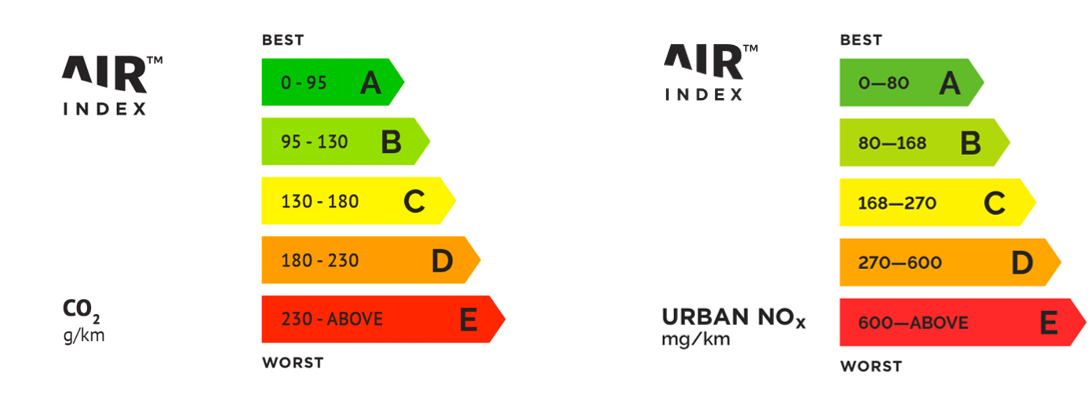AIR Index vehicle emissions ratings system offers first realistic, fully-fledged alternative to official data
- Broad coverage of vehicles offers complete system of ratings for the first time
- Alternative to misleading official nitrogen oxide (NOx) and carbon dioxide (CO2) figures
- For use by cities, fleets, consumers and manufacturers
- Based on thousands of independent, real-world tests
- With coverage of over 90% of model variants in key categories
- Available now free of charge at airindex.com
3 February 2021: The expanded AIR Index ratings programme creates a near-comprehensive system that can be used by cities, vehicle buyers and car makers for policy solutions to, once and for all, target the dirty cars on the road without penalising clean vehicles.
The AIR Index at airindex.com identifies the cleanest cars across the whole market. Until now, and especially since Dieselgate, there have been many studies and reports about real-world emissions. However, these have typically tested a small selection of vehicles, which made them useful only for broad policy development.
If you were a city looking to implement an effective and fair clean air zone (CAZ), or a car retailer looking for trusted insight to inform customers about the real-world emissions of your vehicles, you had no choice except to use the official labelling system. This official system was made up of the New European Driving Cycle (NEDC) tests up until around 2018, followed by the World Harmonised Light-duty Transient Cycle (WLTC) after that.
The former test regime has been discredited as it underestimates real-world NOx, a problem pollutant for urban air quality, by a factor of 4-5, and real-world CO2, the global warming gas, by around 40%, based on research by the AIR Alliance. The WLTC remains a laboratory test with a cycle unrepresentative of the range of real-world driving, despite having smaller discrepancies.
With the launch of this expanded AIR Index programme, cities, retailers and fleet managers now have an alternative. Thanks to the coverage of over 90% of model variants in the key segments, the AIR Index can help make clean air zones and other incentive schemes to work more effectively. It allows the razor-sharp targeting of older, dirtier vehicles, while exempting those that are cleaner. For clarity, models launched since the introduction of the new Real Driving Emissions (RDE) on-road test have all tested clean – and these are not the source of urban air quality problems.
The expanded AIR Index will allow the NOx-related air quality problem to be solved in the quickest and easiest way for cities, with the minimum impact necessary on car owners and fleets.
The AIR Alliance rates vehicles for NOx and CO2 separately, on scales from A to E. The Greater London Authority will be using the AIR Index to power its Cleaner Vehicle Checker, which can be found here. This works in conjunction with the Ultra Low Emissions Zone to inform and incentivise car drivers and buyers.
This expanded service from the AIR Alliance is based upon a recognised, European legal standardisation methodology in the form of CWA17379, published in January 2019, which was the product of CEN Workshop 90. At the heart of the ratings are vehicles that have been tested in full compliance with this methodology. These results are complemented by predicted ratings for most of the rest of the market using a ground-breaking artificial intelligence model that is trained on a large volume of real-world data. These data are from thousands of vehicles that have been tested in carefully controlled conditions on the public highway in the UK and mainland Europe.
The impact of over-emitting diesel-powered passenger cars and vans remains the prime focus for policy makers to improve urban air quality. This is particularly relevant for Euro 5 and pre-RDE Euro 6 diesel vehicles which cover a period from around 2010 until the introduction of RDE around 2018, although not all cause problems by exceeding NOx limits. These models are problematic because there are large numbers of them on the road and they are relatively young, so will remain in the road for many years. Of this generation of models, the expanded AIR Index covers around 90% of all model variants.
Nick Molden, co-founder of the AIR Alliance, said: “Creating a fully-fledged alternative to official ratings has been the objective of the AIR Alliance from the beginning, and we are pleased now to be able to launch the expanded AIR Index to offer an important practical tool to cities, buyers and the industry.”
“Reducing nitrogen oxide emissions is not the only type of pollution that is of concern, but it is perhaps the most pressing in the light of the systematic design problems of vehicles that were revealed by Dieselgate.”
As a not-for-profit organisation, the AIR Alliance is independent of the car industry and governments. Its objective is to bring about reductions in air pollution and gases that contribute to climate change through the power of real-world d
AIR carries out an ongoing programme of vehicle testing, and results are added to the AIR Index periodically.
Inspiration for the AIR Index was NCAP, the independent vehicle-safety rating system developed in the US in the 1970s that became the industry standard in the EU and around the world. The programme held car makers accountable for their safety performance, resulting in a voluntary adoption of technologies that led to safer vehicles.
AIR tests at least two different cars or vans of each model, sold and on the road, sourced independently from the vehicle makers in a scientifically robust programme of on-road trips which lead to an emissions rating in the AIR Index.
The rating of each vehicle uses the latest methodology CWA 17379 developed at European level to fairly compare the emissions performance of different vehicles using portable emissions monitoring systems (PEMS) to ensure that the technology provides trusted data on emissions that is transparent and available to everyone.
The AIR Index ratings for urban CO2 and NOx are rated as follows:
